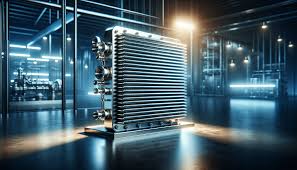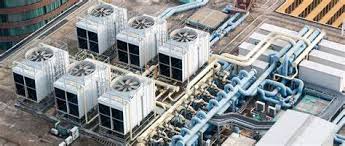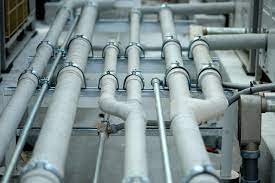The Future of Heat Exchange: Trends and Innovations Shaping the Industry

Strong 8k brings an ultra-HD IPTV experience to your living room and your pocket.
Introduction:
The heat exchange industry is experiencing transformative changes driven by advancements in technology, materials, and design methodologies. These innovations are paving the way for more efficient, sustainable, and versatile systems. From industrial applications to cutting-edge energy solutions, the landscape of heat exchange is evolving rapidly. This article explores the latest trends and innovations that are shaping the future of heat exchange, with a focus on key areas like additive manufacturing, energy efficiency, and sustainable practices.
The Demand for Efficiency and Sustainability
Global energy challenges have heightened the demand for systems that optimize heat transfer processes. Heat exchangers are vital components in industries such as power generation, chemical processing, automotive, and HVAC. By recovering and reusing thermal energy, they contribute to reducing energy consumption and greenhouse gas emissions.
Increasing regulatory pressures for carbon neutrality and energy efficiency standards have also pushed manufacturers to adopt innovative technologies. Compact, lightweight, and highly efficient heat exchangers are becoming the norm, ensuring minimal energy wastage and maximum performance.
Additive Manufacturing in Heat Exchangers: Unlocking Complex Geometries
Additive manufacturing, commonly known as 3D printing, is revolutionizing the design and production of heat exchangers. Traditional manufacturing methods often limit the complexity and efficiency of heat exchangers due to constraints in tooling and fabrication. Additive manufacturing eliminates these barriers, allowing for intricate geometries and optimized structures that enhance thermal performance.
One of the most notable benefits of additive manufacturing is its ability to create highly compact and lightweight heat exchangers. For example, heat exchangers with lattice structures maximize surface area for heat transfer while reducing material usage. These designs are particularly advantageous in industries such as aerospace and automotive, where weight and space are critical factors.
Additionally, additive manufacturing enables rapid prototyping and customization, allowing engineers to test and refine designs quickly. This approach reduces development cycles and costs, making it an attractive option for industries aiming to innovate.
Advanced Materials: Enhancing Performance and Durability
Material innovations are at the heart of the heat exchange revolution. Traditional materials like copper and aluminum, while effective, are being supplemented or replaced by advanced alternatives that offer superior thermal conductivity, corrosion resistance, and durability.
Graphene-based materials, for instance, are gaining attention for their exceptional thermal properties. As a coating or structural component, graphene enhances heat transfer efficiency and protects against wear and tear. Ceramic materials are also emerging as a solution for high-temperature applications, such as those in power plants and industrial furnaces.
Phase-change materials (PCMs) are another area of interest. PCMs absorb and release thermal energy as they change states, providing a stable and efficient way to manage heat in systems requiring consistent temperature control.
Compact and Lightweight Designs
The push for miniaturization has led to the development of compact and lightweight heat exchangers that maintain or exceed the performance of their larger counterparts. Plate and microchannel heat exchangers are prime examples of this trend, offering superior heat transfer efficiency in a smaller footprint.
These designs are particularly relevant in sectors like electric vehicles (EVs), where efficient thermal management systems are essential for battery performance and longevity. By optimizing heat transfer in compact spaces, these exchangers support the growing demand for energy-efficient and sustainable transportation solutions.
Digitalization and IoT-Enabled Heat Exchangers
Digital transformation is reshaping the heat exchange industry. IoT-enabled heat exchangers equipped with sensors can monitor performance metrics in real time, such as temperature, pressure, and flow rates. This data is analyzed to optimize system operation, detect potential issues, and predict maintenance needs.
The integration of Artificial Intelligence (AI) further enhances this capability, enabling intelligent decision-making and adaptive control. For example, AI algorithms can adjust operating conditions dynamically to maximize efficiency and minimize energy consumption.
Download FREE Sample of Artificial Intelligence Market: https://www.nextmsc.com/artificial-intelligence-market/request-sample
Digital twin technology is another game-changer. By creating virtual replicas of heat exchangers, engineers can simulate various scenarios and refine designs before manufacturing. This approach reduces prototyping costs and accelerates innovation cycles.
Renewable Energy Integration
The shift toward renewable energy sources has created new opportunities for heat exchangers. In solar thermal systems, heat exchangers are used to transfer heat from solar collectors to storage or end-use systems. Similarly, geothermal energy systems rely on heat exchangers to extract and distribute heat efficiently.
In the context of hydrogen production, heat exchangers play a critical role in managing temperatures during electrolysis and chemical reactions. Advances in materials and design are improving the efficiency and scalability of these systems, supporting the transition to a hydrogen-based economy.
Heat Recovery Systems
Heat recovery systems are becoming increasingly important in reducing energy wastage across industries. By capturing and reusing waste heat, these systems improve overall energy efficiency and lower operational costs.
Applications include data centers, where waste heat is recycled to provide heating for nearby buildings, and industrial processes, where recovered heat is used for preheating or power generation. Innovations in heat recovery system design are making these solutions more accessible and effective.
Sustainability and Eco-Friendly Solutions
Sustainability is a driving force behind many advancements in heat exchange technology. Manufacturers are exploring eco-friendly materials and designs that minimize environmental impact. For example, recyclable materials and biodegradable components are being incorporated into heat exchangers to reduce waste.
The use of low-global warming potential (GWP) refrigerants in heat exchangers for HVAC and refrigeration systems is another step toward sustainability. These refrigerants reduce the environmental footprint of cooling systems while maintaining high efficiency.
Emerging Applications
The versatility of heat exchangers is leading to their adoption in emerging applications, such as energy storage systems and advanced manufacturing. Thermal energy storage systems, for instance, rely on heat exchangers to manage heat transfer in applications like molten salt storage for concentrated solar power plants.
In advanced manufacturing, heat exchangers are used to regulate temperatures in processes like 3D printing and semiconductor production. These applications highlight the expanding role of heat exchange technology in innovative industries.
Challenges and Opportunities
Despite the advancements, the heat exchange industry faces challenges such as material costs, fouling, and maintenance. However, these challenges also present opportunities for innovation.
For instance, self-cleaning heat exchangers that use advanced coatings or ultrasonic technology to prevent fouling are gaining traction. Similarly, modular designs that simplify maintenance and replacement are being developed to address operational challenges.
Conclusion
The future of heat exchange is marked by a convergence of technological, material, and digital innovations. From additive manufacturing and advanced materials to IoT integration and sustainable practices, these trends are redefining what heat exchangers can achieve.
As industries continue to prioritize energy efficiency and sustainability, the demand for innovative heat exchange solutions will only grow. By embracing these advancements, manufacturers and end-users can unlock new levels of performance, reliability, and environmental responsibility, ensuring that heat exchangers remain a cornerstone of modern technology.
Read the complete blog: https://www.nextmsc.com/blogs/heat-exchangers-market-trends
Note: IndiBlogHub features both user-submitted and editorial content. We do not verify third-party contributions. Read our Disclaimer and Privacy Policyfor details.





